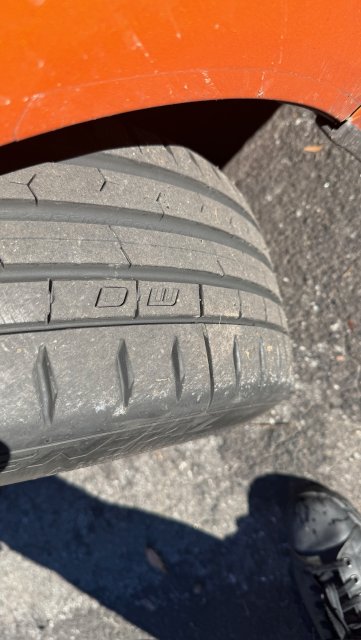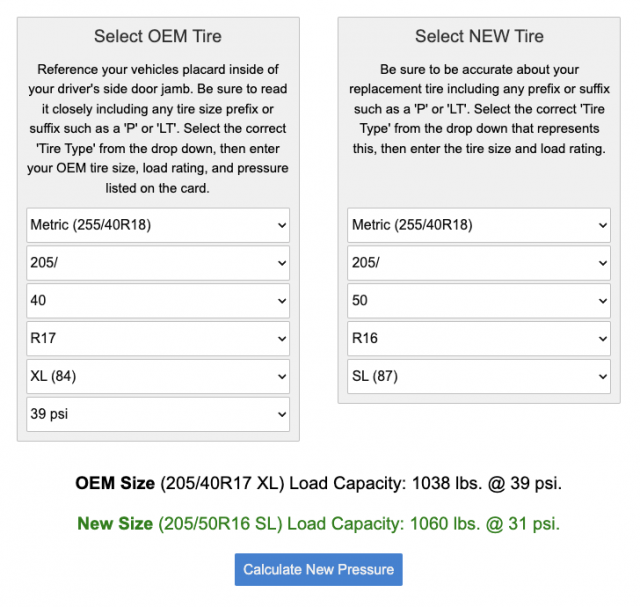-
Sign Up! To view all forums and unlock additional cool features
Welcome to the #1 Fiesta ST Forum and Fiesta ST community dedicated to Fiesta ST owners and enthusiasts. Register for an account, it's free and it's easy, so don't hesitate to join the Fiesta ST Forum today!
My Continental Extreme ContactSport 02 Experience
- Thread starter Snrub
- Start date
Re, what the ECS 02 is about, read some of Andy Hollis from GRM tests and comments, or tire racks tests from last year. On an aside, he did say the ECS 02 works surprisingly well in low, but above freezing temps.
Could you clarify the tread stamp comment? Are you referring to the "tuned performance indicator" that indicates when the tread is low for either condition?
Could you clarify the tread stamp comment? Are you referring to the "tuned performance indicator" that indicates when the tread is low for either condition?

I can vouch for the 215/45R17 Continental ExtremeContact DWS 06 Plus XL (all season) under those temps and they hug the corners surprisingly well.
Unlike UHP/max performance, 300-340 tread wear, SUMMER designated tires. Which yes, with a larger void tread pattern will be great in warmer temp wet conditions, but not in cold conditions wet OR dry.
![Wink [wink] [wink]](/images/smilies/wink.gif)
Yes, because REAL, actual all season tires, which are labeled as such, are compounded to perform decently in lower DRY weather temps (but not great in frozen precipitation!).
Unlike UHP/max performance, 300-340 tread wear, SUMMER designated tires. Which yes, with a larger void tread pattern will be great in warmer temp wet conditions, but not in cold conditions wet OR dry.![Wink [wink] [wink]](/images/smilies/wink.gif)
Unlike UHP/max performance, 300-340 tread wear, SUMMER designated tires. Which yes, with a larger void tread pattern will be great in warmer temp wet conditions, but not in cold conditions wet OR dry.
![Wink [wink] [wink]](/images/smilies/wink.gif)
I'm also running these Conti's, and I wouldn't trust them in cold slick weather like that due to the tread pattern, but I did run them during this past short winter and they did fine. Engineering Explained on youtube tested summer tires and snow tires for dry accelerating and braking in below freezing weather, and the summer tires actually performed better under both circumstances than the snow tires.
The distinction might confuse some folks... the original poster is running Summer whereas mine are all-season. Different compounds and tread patterns. The OE Summer tires under cold temps were rocks LoL...
Yes, THIS!
(WHY I highlighted the 'S' in the post further up thread when referring to the DWS in the Conti DWS-06+
![Wink [wink] [wink]](/images/smilies/wink.gif)
Edit: I’m noting that that 205/45R16 SL does not have adequate load rating for our front axle, which is maybe what you’re referring to (205/50R16 SL should work though, both sizes are technically stretched on an 8” rim (5.5-7.5”). XL rating will not change that.
In any case, either stretch them or get some 7/7.5” rims and run these:
https://www.tirerack.com/tires/tire...ewall=Blackwall&partnum=05WR6DWS06P&tab=Sizes
New pressures will be 35/33psi, or 36/33psi if you decide to keep the 3psi split.
Is there any other particular reason you need XL rated tires? Usually, a particular size is either XL or it’s not at all, primarily in our sizes to keep the max load rating over 1000lbs, which is typically only a problem in very low profile sizes (40 and below, with the occasional 45).
205/45R16 and 205/50R16 are pretty exclusively standard load (SL) rated (don’t forget the R, a dash technically refers to bias/cross ply tires!). In other words, you simply won’t find what you’re looking for. Simply convert load ratings and tire pressure to the new size.
It’s also worth noting that an XL tire requires higher pressures than an SL tire for the same actual load. XL only really exists because the lower profile a tire is, the lower it’s load capacity becomes, and the drive towards “fashionable” low profile tires on modern heavier vehicles necessitated a new standard (aka bandaid approach). XL tires also only have a higher peak load rating because they’re allowed to increase load capacity up to 42psi, where load on SL tires are capped at 36psi for inexplicable reasons, despite the fact that max pressures are much higher than that.
As far as I know, the only deviation from the pattern of sizes in mass market tires is very specific tires - for example the R888R being XL rated for most sizes, and Hoosiers being LL rated for all sizes. Some other tires get designated XL because the particular construction in a size is not adequate without the extra pressure (A052 for example)
Honestly, don’t get hung up on SL vs XL load rating. XL tires with extra plies are generally stiffer, heavier and have worse ride quality. They also are generally designed for the same range of rim widths. As long as you are running appropriate pressure for the load rating, it’s not an issue.
You are also not required to have a certain peak load rating on a car (86, 88, 91, etc), tires are rarely ever specified to run at peak pressure. What you do need is the actual load point and the appropriate pressure for that load.
Use this calculator.
https://tiresize.com/pressure-calculator/
In any case, either stretch them or get some 7/7.5” rims and run these:
https://www.tirerack.com/tires/tire...ewall=Blackwall&partnum=05WR6DWS06P&tab=Sizes
New pressures will be 35/33psi, or 36/33psi if you decide to keep the 3psi split.
Is there any other particular reason you need XL rated tires? Usually, a particular size is either XL or it’s not at all, primarily in our sizes to keep the max load rating over 1000lbs, which is typically only a problem in very low profile sizes (40 and below, with the occasional 45).
205/45R16 and 205/50R16 are pretty exclusively standard load (SL) rated (don’t forget the R, a dash technically refers to bias/cross ply tires!). In other words, you simply won’t find what you’re looking for. Simply convert load ratings and tire pressure to the new size.
It’s also worth noting that an XL tire requires higher pressures than an SL tire for the same actual load. XL only really exists because the lower profile a tire is, the lower it’s load capacity becomes, and the drive towards “fashionable” low profile tires on modern heavier vehicles necessitated a new standard (aka bandaid approach). XL tires also only have a higher peak load rating because they’re allowed to increase load capacity up to 42psi, where load on SL tires are capped at 36psi for inexplicable reasons, despite the fact that max pressures are much higher than that.
As far as I know, the only deviation from the pattern of sizes in mass market tires is very specific tires - for example the R888R being XL rated for most sizes, and Hoosiers being LL rated for all sizes. Some other tires get designated XL because the particular construction in a size is not adequate without the extra pressure (A052 for example)
Honestly, don’t get hung up on SL vs XL load rating. XL tires with extra plies are generally stiffer, heavier and have worse ride quality. They also are generally designed for the same range of rim widths. As long as you are running appropriate pressure for the load rating, it’s not an issue.
You are also not required to have a certain peak load rating on a car (86, 88, 91, etc), tires are rarely ever specified to run at peak pressure. What you do need is the actual load point and the appropriate pressure for that load.
Use this calculator.
https://tiresize.com/pressure-calculator/
I just installed a set of 205/50R16 DW06+ on 16x6.5in OEM titanium fiesta wheels, and I need to drop down the pressure even more. I've never heard of a calculator like this.

Very neat calculator! I had my tires over-inflated for years if this is right. I had a set of 205/45R17 BFGoodrich G-Force Comp-2 A/S on the OEM wheels, they needed to be at 34 PSI instead of the factory 39 PSI I set them to.
I just installed a set of 205/50R16 DW06+ on 16x6.5in OEM titanium fiesta wheels, and I need to drop down the pressure even more. I've never heard of a calculator like this.
View attachment 61084
I just installed a set of 205/50R16 DW06+ on 16x6.5in OEM titanium fiesta wheels, and I need to drop down the pressure even more. I've never heard of a calculator like this.
View attachment 61084
Tire pressures are subjective. I may lower/raise them based on traction conditions and wear patterns.
Had a set of Cooper brand tires that I quickly got rid of due to non-stop issues with slow leaks and punctures.
Had to let a lot of air out of them to get up the snowy hill at home. (turn traction control OFF)9
When I want stiffer handling/ride like the OEM set I'll increase pressures.
On a prior vehicle I'd adjust pressures to "square up" the tire tread profile for more even wear.
It is IMPORTANT to note, that you must adhere to the door jamb sticker in terms of pressure difference between front and rear tires.
In other words, do not set your pressures even all the way around and worse, do not set pressures higher in the rear; the vehicle will fish-tail.
Make sure you pay attention to this when rotating your tires.
Also note that lower pressures generate more heat in the tire which can expose problems and defects.
Had a set of Cooper brand tires that I quickly got rid of due to non-stop issues with slow leaks and punctures.
Had to let a lot of air out of them to get up the snowy hill at home. (turn traction control OFF)9
When I want stiffer handling/ride like the OEM set I'll increase pressures.
On a prior vehicle I'd adjust pressures to "square up" the tire tread profile for more even wear.
It is IMPORTANT to note, that you must adhere to the door jamb sticker in terms of pressure difference between front and rear tires.
In other words, do not set your pressures even all the way around and worse, do not set pressures higher in the rear; the vehicle will fish-tail.
Make sure you pay attention to this when rotating your tires.
Also note that lower pressures generate more heat in the tire which can expose problems and defects.
Last edited:
Similar threads
-
FS Sparco Assetto Gara 16x7 with Continental ExtremeContact Sport 02 205/45R16
- Started by gerhske12
- Replies: 14
-
FS Konig Lockouts 16x7.5 with 205/45/16 Continental Extremecontact (TX)
- Started by Chris_Fist
- Replies: 5
-
SLD SOLD 16x8 4x108 Konig Dekagram w/ 205/45/16 Continental Tires w/ TPMS
- Started by dc_stanley
- Replies: 4
-
SLD Free things: Continental DWS 06 Tires, OEM Door Stickers
- Started by swirlmarks
- Replies: 49
-
SLD SOLD: Konig Dekagram (4), 15x8, +35mm, 4x108, Matte Black, w/ Continental Tires
- Started by facingeast
- Replies: 4
-
SLD [DMV] 16x7 Sparco Terra LT GREY - 205/45ZR-16 Continental ExtremeContact Sport SL ($600)
- Started by anekdotos
- Replies: 0
-
New Tire Rack Extreme Performance Summer Tires , FALKEN,Yokohama,Continental,Kumho
- Started by Dpro
- Replies: 18
-
205/50/15 continental extreme contact sport purchased by me and weighed
- Started by LILIKE16ST
- Replies: 27
-
Continental ExtremeContact Sports on 16" aftermarket wheels vs Michelin Pilot Super sports on Stock wheels
- Started by vikster101
- Replies: 8
-
Ford Community Posts
-
-
-
-
FS $12,xxx 2016 Molten Orange 60k miles w/ S280, Suspension, E30, ...
- Latest: thomas50shades
